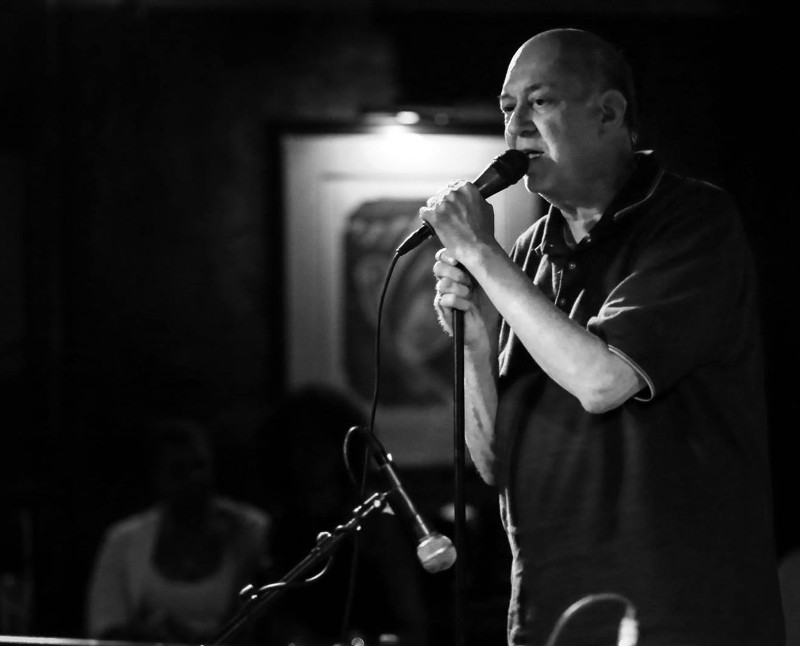"Conversations on Mortality" at 22 North looks to transcend the silence about the dying side of living

Conversations on mortality are difficult, often avoided, and in America, they are traditionally taboo. The 22 North gallery in Ypsilanti welcomes the thought-provoking exhibit Conversations on Mortality, which confronts our impermanence, the inevitability of death.
The exhibition's multimedia works engage with loss, mourning, and what is left behind once someone is gone. Described by the curators as “a chance to transcend the silence,” Conversations on Mortality offers works driven by the lives of the artists. Not only do they address the complexity of their mortality and loss of loved ones, but also their experiences of living with disability, illness, and the impact of COVID-19.
Entering the space, hanging lanterns in an autumnal palette cheerily frame serendipitously matching works by curators Sharlene Welton and Tim Tonachella. I had a chance to speak with Welton who is both the show’s curator and an artist when I visited 22 North. Welton said she created the lanterns as part of an interactive element to the opening night, where visitors were able to decorate and write their names on the lanterns before hanging them. The pieces by Welton (a large painting) and Tonachella (two photographs of cemetery views) were brought in last minute when an artist was unable to make the show, but adding the works ended up being a great aesthetic success.
Welton and Tonachella’s gallery statement notes the overlapping threads among the works, as artists grapple with the questions, “How do we embrace the changes that come from death and dying, and more importantly, how we assimilate the loss into our daily living?” Though these may, ultimately, be unanswerable questions, they are worth asking—especially when operating within a mainstream American culture that predominantly ignores them.
Songs of the Night: Berlin Philharmonic brought Mahler's 7th back to Hill Auditorium

I’d be shocked if there were a single empty seat in the house last Saturday night.
As people ducked out of the swirling snow flurries of the storm that would blanket the town over the course of the next few hours, the lobby of the 3,000-seat Hill Auditorium began to fill to the brim with eagerly bustling patrons.
And no wonder—it’s not every day that you have the chance to hear what’s arguably the world’s best orchestra perform music by one of history’s best composers.
It’s been six years, almost to the day, since Ann Arbor heard from the Berlin Philharmonic, courtesy of the University Musical Society (UMS). When they last played Hill, to a similarly packed house, Simon Rattle was still at the helm of the orchestra, two years away from stepping down as chief conductor and artistic director, roles he’d held since 2002. I managed to attend one concert out of two that year, and it remains etched in my memory as one of the best orchestral experiences I’ve ever had—a thrilling offering of music from the Second Viennese School and a Brahms symphony that was all conducted, impressively, from memory.
Saturday’s performance was no less remarkable.
Friday Five: Same Eyes, prod. P, Color TV, autodoom., Otherseas

Friday Five highlights music by Washtenaw County-associated artists and labels.
This week features synth-pop by Same Eyes, beat sketches by prod. P, bedroom indie-folk by Color TV, lo-fi hip-hop shoegaze by autodoom., and an emotional MEMCO Exposure mix by Otherseas.
Immersion Therapy: Hannah Baiardi Unpacks Emotions on “Ascend Your Vibe: Music for Contemplation” Piano Instrumental Album

Hannah Baiardi immerses herself in a cathartic sonic experience on her new album, Ascend Your Vibe: Music for Contemplation.
The Ann Arbor singer-songwriter and pianist delved into jazzy sophisti-pop on her last two records, Magic (2022) and Straight From the Soul (2021), but Ascend Your Vibe explores the restorative side of mellow instrumental music.
“I brought all my emotions to the piano bench and got to unpack them in real-time at the keys,” said Baiardi about her fourth album. “The longer strings of phrases are riding a feeling while the pauses are the reflection and the process. The feelings drive the ebb and flow and unfolding of each piece.”
Throughout Ascend Your Vibe: Music for Contemplation, Baiardi unfolds feelings of hope, gratitude, and wonder across eight spiritual tracks, including the magical opener, “Pensive,” and the otherworldly “Somewhere East of Here.” Glistening keys slowly strike and pause alongside tranquil samples featuring soothing birds and a ticking clock.
“As a listener, you can choose where to direct your attention. The clock can ground or distract you,” writes Baiardi on her Bandcamp page. “The anticipation before a chord can make you focus on the next chord or can help you be in the in-between spaces.”
To get inside her headspace, we recently talked with Baiardi about her musical beginnings, favorite artists, and latest album.
David Fenton's "The Activist’s Media Handbook" traces his life in the media, from the "Ann Arbor Sun" to progressive public relations

Activist and public relations firm founder David Fenton launched his very first PR campaign in Ann Arbor in 1971: Fenton worked to get John Sinclair out of prison where he was serving a sentence for giving drugs to an undercover agent.
Following this effort, Fenton wrote for the countercultural newspaper Ann Arbor Sun where he worked on a campaign to increase sales by running a contest called “Win a Pound of Colombian Marijuana.”
Fenton’s new book, The Activist’s Media Handbook: Lessons From 50 Years As a Progressive Agitator, spends two chapters on his time in A2 and also details what happened before and after.
Of his time working at the newspaper and in activism, Fenton writes:
Friday Five: Kingfisher, Riot Course, Kai West, Hues, Anhedonia

Friday Five highlights music by Washtenaw County-associated artists and labels.
This week features large-ensemble indie rock by Kingfisher, polished punk via Riot Course, guitar ambiance from Kai West, hip-hop by Hues, and genre-agnostic electronica by Anhedonia.
Group Swim: PTD Productions' "The Sweet Delilah Swim Club" makes a splash on the importance of friends

The Sweet Delilah Swim Club celebrates the friendship of five women over time. Artwork courtesy of PTD Productions.
PTD Productions' The Sweet Delilah Swim Club is funny, heartwarming, and shows the beautiful bonds of five women just trying to get through life.
This comedy, written by Jessie Jones, Nicholas Hope, and Jamie Wooten, takes us to North Carolina and introduces us to a group of girlfriends who met swimming for their college swim team. Every year during the same weekend in August, they rent out the same beachside cottage in the Outer Banks and use that time to catch up with one another and have a yearly group swim. Time progresses rapidly in this show, with the first scene taking place 22 years after graduation and the characters in their early 40s. By the end of the show, another 33 years have passed and the ladies are in their 70s.
Marie Jones plays Sheree, the former captain of the team and the group’s Type A organizer. She has a set schedule for each day and gets overwhelmed if the schedule doesn’t go according to plan. Sheree's weird health food disgusts her friends even though they all pretend to like it. Jones’ performance is endearing and honest as she navigates a character learning to give up some control.
Things to Do: Pulp Event Roundup for November

To fill up your November calendar, we’ve compiled a comprehensive list of arts-related events, exhibits, and more throughout Washtenaw County. Check out some local cool happenings in music, visual art, theater and dance, and written word and film.
MUSIC
Bill Edwards
November 11
Canterbury House, Ann Arbor
Ann Arbor singer-songwriter and multi-instrumentalist Bill Edwards performs tracks from his new Americana album, Thirteen Stories. Throughout his latest release, Edwards pens sentimental stories from different perspectives, including a hall-of-fame baseball player, a seasoned songwriter, and a nostalgic boater. Read our preview and interview here.
Nervous But Excited
November 11
The Ark, Ann Arbor
Ten years after their sold-out finale at The Ark, the local folk duo of Kate Peterson and Sarah Cleaver reunite for one of their final Nervous But Excited performances. Their repertoire ranges from smart, introspective narratives to the tactfully political while interspersing songs of love and loss.
Olivia Van Goor
November 11
Blue Llama Jazz Club, Ann Arbor
The Milford jazz vocalist is influenced by swing and bebop jazz from the mid-20th century. Van Goor unearths and reshapes gems from the Great American Songbook and other jazz standards in a way that’s beyond replicating what has already been done before. Read our past interview with Van Goor here.
All for the Music: Remembering longtime WEMU and WCBN DJ Michael G. Nastos

Michael G. Nastos, a longtime music journalist and radio DJ in Ypsilanti and Ann Arbor, died over the weekend. He was 70 years old.
Nastos had been struggling with health problems and was using a wheelchair for the past year or so in public appearances—of which there were many.
Because even with the issues he was facing, nothing could keep Nastos away from engaging with the driving love of his life: music.
U-M's production of the musical tragedy "Bernarda Alba" mixes period costumes and an abstract set to confront contemporary issues facing women

Fredrico Garcia Lorca wrote The House of Bernarda Alba in 1936, shortly before he was murdered by a nationalist firing squad during the Spanish Civil War. Michael John LaChiusa shortened the title to Bernarda Alba when he set the play to music and added lyrics; he made some changes to the play while keeping the essential story:
Bernarda Alba assumes the role of family head after her husband’s funeral. She orders her five unmarried daughters, ages 20-39, to mourn for eight years, as her mother did before her. It will be as though the house is bricked up; even crying is forbidden. One problem is that three of the sisters are enamored with the handsome Pepe el Romano—the eldest is engaged to him—and jealousy takes center stage. But what exactly can the sisters do under the circumstances? Turns out, some life-altering things.
When the musical tragedy opened at Lincoln Center in New York in 2006, the scenic design was drab, a realistic depiction of this closed and lonely home.
For Linda Goodrich's production of LaChiusa's Bernarda Alba adaptation that's running November 10-13 at the University of Michigan, scenic designer Jungah Han dropped the drab for what Goodrich calls a “wildly inventive” set. The stark red floor is bordered by a black playing area, with a kind of ceiling that descends to oppress the characters. Actors step out of character and onto the rim at times to witness the action or to narrate.


































